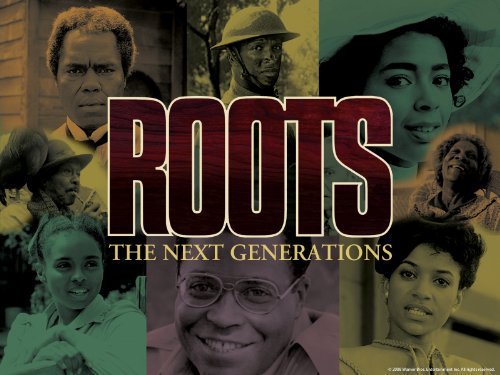There are some things in life that just completely take this world by surprise. The TV miniseries Roots, premiering in 1977, did just that. Roots, based on Alex Haley’s own “roots,” is about a young African man who is stolen from his village in Africa, sold into slavery, and taken to the United States. This miniseries follows the life of protagonist Kunta Kinte sparing no details of the brutality of slavery in showing how it slowly broke his spirit, and how it affected members of his family over three generations.1 When the miniseries Roots premiered on January 23, 1977, an astonishing twenty-nine million American households tuned in to watch, shocking the ABC network executives.2 Roots the miniseries sparked a fire within the hearts and lives of many Americans, inspiring them to research and understand their own roots. It also sparked a conversation about race and slavery in the United States that was unprecedented. This mini-series’ impact forever changed those who had watched it and changed American culture as a whole.

The casting process for the TV adaptation was done in an extremely cautious and deliberate manner. The ABC Network executives were very skeptical about the potential success of the show, despite the novel already being on the best seller’s list. Before the airing of the miniseries, there were several conversations about how the network would cut their losses. The first step would be to premiere the eight-part series in eight consecutive days. The thought process behind this was that if it was a flop, it would only be for a little over a week instead of the drawn-out weekly fashion that a typical series takes. The cast selection was also completed very meticulously. Then ABC network’s entertainment president, Fred Silverman, and his other executives decided that familiar faces and a star-studded cast would be the safest bet.3 This cast included big names like football star OJ Simpson, Robert Reed of The Brady Bunch, and famous poet Maya Angelou. Another strategic casting measure that was taken by network executives was casting Edward Asner as the white man who was morally conflicted in the role he played in the slave trade as a ship captain–this was a decision made to help white audiences feel better about what roles their ancestors had played in the slave trade. Outside of these strategies, in the promotional videos, the white actors were featured prominently in the promotional videos. Once again, if all of this were to fail, the miniseries would be set to run eight consecutive nights in order for it to fail on a shorter timetable.
Prior to the 1970s, roles that African Americans played were very limited. Hollywood had a diversity problem. The cast of Roots was the largest black cast that television had ever seen prior to its premiere. Even with such a dynamic cast such as this series and its award-winning success after the show, it was still hard to find acting jobs. This was not new for African Americans in Hollywood. Throughout the duration of the 1900s in Hollywood, minorities did not really have a role to play. If they did, it was usually one of three themes: from rags to riches, something about segregation, or thug life. The first time an African American played a role that stirred some sort of controversy was when Hatty McDaniel played house servant Mammy in Gone with the Wind. It was roles like these, the only roles that African Americans were offered, that only continued to perpetuate the stereotype that African Americans were only a certain type of person – the type subservient or delinquent. Playing these demeaning caricatures were the only way that actors were able to find work. In the early parts of the twentieth century, Hollywood went to the extreme of having white actors use blackface. The usage of blackface allowed Hollywood the ability to portray people of color without actually having to hire them. While blackface eventual died out in Hollywood because of its racist connotation, the problem of not having people of color in the film industry still persisted. While the 1970s helped usher in a newer era on the television side of Hollywood, with television series like The Jeffersons, Good Times, Sanford and Son, Fat Albert, the Bill Cosby Show, and Julia, working in Hollywood was still full of discrimination. 4 In 1977, the US Commission on Civil Rights issued a report, Window Dressing on the Set: Women and Minorites on Television. This report cites a quote from a highly esteemed broadcasting historian, Erik Barnouw, saying, “Radio had been close to lily-white, but implicitly. Television was explicitly and glaringly white. A seeming mirror of the world, it told the Negro continually that he did not exist except in ‘insults’ like Amos’n’Andy.”5. The NAACP fought with broadcasting networks because their portrayal supported that conclusion, that African Americans were inferior, dishonest, lazy, and dumb. Since the first Academy Awards ceremony took place in 1929, over 3,000 awards have been given – of those 3,000 awards, a total of 36 recipients had been African Americans.6 The series spares no graphic detail in depicting the horrors of slavery, unlike previous depictions in films like Gone with the Wind. Despite putting the best-selling novel into production, the executive producers were still scared that it would be controversial for American viewers. With the release of the miniseries, the romanticized perception of slavery was challenged. In Roots, Haley mixes historical and fictional accounts to tell the story of an American family. Beginning in the 1800s, when the family’s African ancestors lived, the novel moves through the Middle Passage, the horrors of slavery, the centuries of oppression, the Civil War, and the Reconstruction Era. The miniseries focuses on the life of Kunta Kinte and the generations of his family that follow him. Kunta grows up in a village in Gambia where he is later captured by slave traders, taken to Annapolis, Maryland, and sold into slavery. Kunta Kinte marries and has a child, but throughout the series, he works to keep his own African culture alive within himself, despite his slave owners trying to break his spirit and Christianize him. Even after Kunta’s death, the story is told through the life of his daughter, Kizzy. Kizzy was educated in secret and helped another slave escape and was caught, so she was sold to a man who repeatedly rapes her. Eventually, she bears a son, Chicken George.7
The narrative speeds through the lives of Chicken George’s descendants to reach Alex Haley, the author, who has been writing the saga of his own. Then network president, Fred Silverman, despite having a popular and well known African-American cast, was still nervous about airing a drama about an African family– from slavery to freedom, and in only eight days.
Prior to the release of the miniseries, Americans had felt that they had an understanding of what slavery was like in the United States. This sentiment was especially true after the release of the film Gone with the Wind. Gone with the Wind provided the picture and idea of the faithful and devoted slave who lived to please his or her masters. This is especially seen in Hattie McDaniel’s Mammy. Mammy is Scarlett’s childhood nurse. Mammy is an old, heavyset slave who had also been a nurse to Scarlett’s mother. She is loyal to Scarlett and is well-versed in Southern etiquette. The portrayal of Mammy’s comfortability with her role as a slave is controversial. One of the biggest criticisms levied toward Mammy is that she represents an affirmative slave and owner relationship and, in fact, seems relatively happy with her lot in life.8 This has been a toxic and inaccurate portrayal of slavery perpetuated by the film and by Hollywood. What an important difference between these two depictions is that Gone with the Wind tells the story not from Mammy’s perspective but from Scarlett’s and Roots tells the story of Kunta Kinte from Kunta Kinte’s perspective and his family from the slave’s perspective; this is a first.When the miniseries first premiered on January 23, 1977, an unexpected twenty-nine million households tuned in to watch the story of Kunta Kinte. As the series progressed through the eight days, more viewers tuned in each night. On the last night, the miniseries drew in thirty-six million households, which is roughly over one hundred million Americans. At the time, the finale was the most watched single episode in all of American television (this record would only be broken by M*A*S*H finale in 1983).9 This miniseries became a worldwide sensation and was the first one to ever do so. The series created a national conversation and inspired many American to investigate into their own family lineage and family histories for the first time. The miniseries is not considered a blockbuster, a designation given to television shows and movies where three out of every ten households watched – Roots eclipses this by having a whopping sixty-seven percent of American televisions on the last night.10 After the airing of the last episode, it inspired a naming fever with Kunta and Kizzy becoming popular baby names. In February of 1977, at least twenty babies were given the name Kunta in New York City, fifteen in Los Angeles, and ten in Detroit topping the top 600 male baby names in the country. A Harlem resident, Nefhertiti Reid, who birthed her son Kunta Kinte Reid, said that by giving her son this name, he would symbolize self-awareness, pride, and freedom.11 In the 1980s and 1990s, children who had grown up and seen Roots came to see Kunta Kinte as a shared character of the culture. When some of these children grew up and became filmmakers of their own, they began to tackle issues of racism in films that would frequently reference Kunta Kinte, like the classic Do the Right Thing, Boyz in the Hood, and the Fresh Prince of Bel Air.12 Traditions that were seen for the first time in the miniseries became featured in other films, like raising a newborn in the air to ask for blessings, as recently depicted in The Lion King. Kunta Kinte is frequently referenced in rap today and is specifically referenced in songs by Missy Elliot, Busta Rhymes, and Future. Kunta Kinte’s name is referenced over 277 times in the Rap Genius archives.13
What are the most-watched shows on television these days? For network TV, The Big Bang Theory, with over fourteen million viewers, followed by Empire, with twelve and a half million (Empire led among black viewers.) In terms of regular cable television, The Walking Dead dominated with fourteen million viewers. In the premium realm of HBO and STARZ, the season premiere of HBO’s popular Game of Thrones drew roughly eight million viewers. Compare that to Roots and one hundred million Americans in 1977.] America’s population was just two hundred and twenty million then, and it is three hundred twenty-three million now, and nearly twenty-nine million households watched Roots that first night.14 By the finale, more than thirty-six million households (one million-plus individuals) were tuned in. It was the most-watched miniseries in history and in today’s terms eclipses what is on television today.

It has been forty-two years since the original premiere of the Roots the miniseries. The impact still persists on generations to come–ROOTS: The Next Generation. The remake of the original series delves deeper and reaches out to the newest generation. The original miniseries has impacted Americans not only during its original airing but for many years later. This miniseries inspired not only names for children, television, movies, but most importantly, a truthful and unprecedented account of slavery—a part of America’s cruel past that was romanticized for far too long.
- Tina Gianoulis, “Roots”, St. James Encyclopedia of Popular Culture, vol. 5 (2013). ↵
- Sandra Ball-Rokeach, Joel W. Grube, Milton Rokeach, “‘Roots: The Next Generation’ – Who Watched and with What Effect?” Public Opinion Quarterly, vol. 45 (1981): 58. ↵
- Matthew Delmont, “Making Roots: A Nation Captivated” Publishers Weekly, vol. 263, no. 26 (June 2016): 76-77. ↵
- Christian Hoag, “Diversity in Hollywood.” CQ Researcher vol 26, no. 28 (2016): 649. ↵
- United States Commission on Civil Rights, “Window Dressing on the Set: Women and Minorities in Television”, (Washington D.C., 1977), 4-7, https://www2.law.umaryland.edu/marshall/usccr/documents/cr12t23.pdf ↵
- Yolanda Sangweni, “The Way-Too-Short List of Black Oscar Winners,” Essence (February 2019) https://www.essence.com/celebrity/way-too-short-list-black-oscar-winners/. ↵
- Matthew Delmont, “Making Roots: A Nation Captivated,” Publishers Weekly vol. 263, no. 26 (June, 2016): 76-77. ↵
- Jannette Dates and Thomas A. Mascaro, “African Americans in Film and Television: Twentieth-Century Lessons for a New Millennium,” Journal of Popular Film and Television, vol 33, (2010): 52. ↵
- Sandra Ball-Rokeach, Joel W. Grube, Milton Rokeach, “‘Roots: The Next Generation’ – Who Watched and with What Effect?” Public Opinion Quarterly, 45 (1981): 58-59. ↵
- Sandra Ball-Rokeach, Joel W. Grube, Milton Rokeach, “‘Roots: The Next Generation’ – Who Watched and with What Effect?” Public Opinion Quarterly, 58 (1981): 58-59. ↵
- Patrick Sisson, “ROOTS: A Cultural Force That Changed The Nation,” September 2018, The New York Times. https://www.nytimes.com/paidpost/history/roots-a-cultural-force-that-changed-the-nation.html. ↵
- Patrick Sisson, “ROOTS: A Cultural Force That Changed The Nation,” September 2018, The New York Times. https://www.nytimes.com/paidpost/history/roots-a-cultural-force-that-changed-the-nation.html. ↵
- Patrick Sisson, “ROOTS: A Cultural Force That Changed The Nation,” September 2018, The New York Times. https://www.nytimes.com/paidpost/history/roots-a-cultural-force-that-changed-the-nation.html. ↵
- Sandra Ball-Rokeach, Joel W. Grube, Milton Rokeach, “‘Roots: The Next Generation’ – Who Watched and with What Effect?” Public Opinion Quarterly, vol. 45 (1981): 58-59. ↵



17 comments
Charli Delmonico
This article was very informative and interesting. I hadn’t ever heard of this show and I now feel inspired to look into it. I’m amazed at how no other show before this had shown the true horrors of slavery and how it affected African Americans, and I’m even more surprised that this was really the first large-scale thing to show how difficult life was for people. I’m glad that the series was such a big hit; it truly deserved the attention it received and I’m glad that it opened doors to new conversations that hadn’t ever been brought up before.
Nicole Ortiz
I had never heard of this miniseries until now but I’m glad that I did. Im so happy that there are people willing to risk their lives and reputations to produce shows and movies about these kinds of topics, especially having an almost all African American cast; that was a really big risk to take in Hollywood during this time period. It made me so happy to read how successful this miniseries was and how much attention it had brought to the topic of slavery and injustice. I hope that there continue to be more shows and series like these that change not only the movie industry but society as well
Brisella Olivares
I have never seen or heard of this show, but this article does a good job in describing the impact it had on African American Hollywood actors. I like how this article not only gives the background behind the miniseries, but also behind the history of African American actors who struggled to get good acting jobs. Its crazy to think white people hated African Americans so much that they had to create blackface instead of just hiring ACTUAL African Americans and calling them lazy when they were begging for bigger better roles in movies.
Edith Santos Sevilla
The article is very descriptive and well written and tells the story not only if the miniseries Roots, but it also gives a background to African American history in television. As stated in the article Hollywood was discriminating against people of color by not given them the opportunities of get an acting job, and when they did it was representing a slave or a worker. The way in which they treated African American people was racist. What I liked about the article was that it showed the transition of acting jobs and it was an important moment for African Americans to be able to get primary roles in television.
Andrea Degollado
Honestly I have never heard of ROOTS, but this article was a real eye opener. I knew that back in the day most African Americans weren’t allowed to participate in most things such a theater or films and etc but I didn’t know white people used the method blackface to replace them. This article honestly shed light on this issue and made me want to watch the show.
Michael Thompson
The impact of the series is quite mind boggling from reading this paper. I mean not only did it show the history of slavery for African Americans and highlighting their trials, but also opened doors for African American’s in the Hollywood scene. And by highlighting these sad truths of the past, it shed light to millions, more than anything else before or after, practically changing history books, which is amazing.
Cynthia Perez
I really like that ROOTS was considered a series that was direct and had the ability to express the truth behind all of what Hollywood wanted to hide. Trying to portray African Americans through white people is such an ignorant act of segregation by excluding their truth and their genuine perspective of most aspects whites couldn’t depict. So for this show to have as many black actors as it did, it meant that there would be a more explicit visual of how they were affected and how life was with these issues going on around at the time. It also signifies a much needed change of unnecessary exclusion and a step in the right direction.